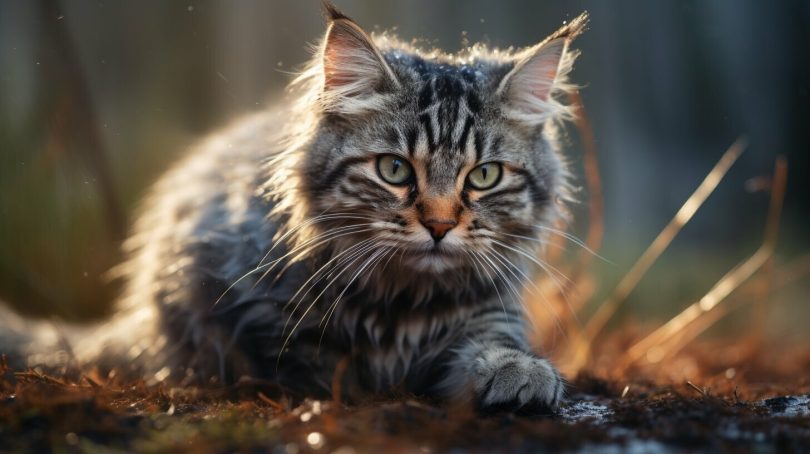Welcome to my guide on understanding American Shorthair shedding and how to manage it effectively. American Shorthair cats are known for their beautiful short coats, but like all cats, they do shed. However, compared to longer-haired breeds, shedding is less of a problem for American Shorthairs. In this article, I will provide you with valuable insights into American Shorthair shedding and practical tips to help you keep your cat’s shedding under control.
Key Takeaways
- American Shorthair cats shed, but shed less compared to longer-haired breeds.
- Shedding is more likely to occur during the spring when their winter coat is shed.
- Regular grooming and brushing help remove loose hair and prevent fur ingestion.
- Factors such as skin irritations, poor nutrition, and high levels of stress can contribute to excessive shedding.
- Addressing underlying health issues and minimizing stress can help reduce shedding.
Why Do American Shorthair Cats Shed?
There are several factors that contribute to American Shorthair shedding, including their shedding cycle and other underlying causes. It’s important to understand these factors in order to effectively manage and minimize shedding in these cats.
One of the main reasons American Shorthair cats shed is due to their shedding cycle. Like many other animals, cats go through a natural process of shedding old or damaged hair and replacing it with new hair. This shedding cycle is more noticeable in the spring when American Shorthairs shed their thicker winter coat to make way for a lighter summer coat. During this time, you may notice an increase in shedding.
In addition to the shedding cycle, there are other underlying causes that can contribute to excessive shedding in American Shorthairs. Skin irritations, such as flea infestations or allergies, can lead to increased shedding. It’s important to regularly check your cat for fleas and address any skin irritations promptly to minimize shedding.
Poor nutrition can also play a role in shedding. A balanced diet that provides essential nutrients, such as Omega-3 fatty acids, can help maintain a healthy coat and reduce shedding. High levels of stress can also contribute to shedding in American Shorthairs. Cats are sensitive animals, and stress can manifest in various ways, including excessive shedding. Minimizing stressors in your cat’s environment and providing a safe and calm space can help reduce shedding.
| Factors Contributing to American Shorthair Shedding |
|---|
| Shedding cycle |
| Skin irritations (fleas, allergies) |
| Poor nutrition |
| High levels of stress |
While it’s not possible to completely eliminate shedding in American Shorthair cats, regular grooming and proper care can help manage and control shedding. Regular brushing helps remove loose hair and prevents the cat from ingesting fur, which can lead to hairballs. Remember to use a cat brush suitable for their short coat. Additionally, maintaining a clean environment through regular vacuuming can help minimize the amount of cat hair in your home.
By understanding the factors that contribute to American Shorthair shedding and taking proactive steps to manage it, you can ensure that your cat maintains a healthy coat and reduce the amount of shedding in your home environment.
Managing American Shorthair Shedding
To minimize American Shorthair shedding, implementing proper grooming techniques and addressing potential triggers is essential. As a cat owner, it is important to understand that while shedding is a natural process, excessive shedding can be managed and controlled with the right approach.
Grooming plays a vital role in keeping shedding under control. Regular brushing helps remove loose hair, preventing it from spreading throughout your home and being ingested by your cat. It is recommended to use a fine-toothed brush or a grooming glove to effectively remove loose fur from your American Shorthair’s coat. This not only helps reduce shedding but also promotes a healthy and glossy coat.
In addition to regular brushing, maintaining a clean and well-groomed cat also involves addressing any underlying skin irritations or allergies. Fleas and allergies can contribute to excessive shedding in American Shorthairs, so it is crucial to ensure regular flea prevention measures and consult a veterinarian for any potential skin issues. Proper nutrition is also important in minimizing shedding. Providing a balanced diet with essential nutrients can help promote a healthy coat and reduce shedding.
| Few Grooming Tips for Managing American Shorthair Shedding: |
|---|
| Regular brushing with a fine-toothed brush or grooming glove |
| Ensure regular flea prevention |
| Consult a veterinarian for any skin irritations or allergies |
| Provide a balanced diet with essential nutrients |
Reducing Stress for Reduced Shedding
Stress can also contribute to excessive shedding in American Shorthairs. Creating a calm and stress-free environment is important to minimize shedding. Provide your cat with plenty of interactive toys and playtime to keep them mentally and physically stimulated. Additionally, ensure your cat has a safe space where they can retreat when feeling overwhelmed. Gradual introductions to new experiences and changes in routine can also help reduce stress levels and subsequent shedding.
Remember, while it may not be possible to completely eliminate shedding in American Shorthair cats, proper grooming techniques, addressing potential triggers, and providing a stress-free environment can significantly minimize shedding and help you and your cat enjoy a cleaner and healthier home.
Tips for Grooming an American Shorthair
Grooming an American Shorthair involves a few simple steps to keep their coat healthy and minimize shedding. Regular brushing is essential, as it helps remove loose hair and prevents matting. Use a soft-bristled brush or a grooming mitt to gently comb through their short coat, paying attention to areas prone to tangles, such as behind the ears and under the armpits.
Bathing your American Shorthair should be done occasionally, as they are generally clean cats that groom themselves. Use a cat-specific shampoo and lukewarm water, ensuring to rinse thoroughly. After bathing, gently towel dry your cat and provide a warm, draft-free area for them to fully dry off.
Trimming your cat’s nails is another important aspect of grooming. Use cat nail clippers or human nail clippers with a straight edge to carefully trim the tip of each nail. Be cautious not to cut too close to the quick, as it can cause bleeding and discomfort for your cat. If you’re unsure how to trim your cat’s nails, consult your veterinarian or a professional groomer for guidance.
Table: Grooming Tools for an American Shorthair
| Tool | Description |
|---|---|
| Soft-bristled brush | Ideal for gently removing loose hair and preventing matting. |
| Grooming mitt | An alternative to a brush, providing a soothing massage while removing loose hair. |
| Cat-specific shampoo | Mild and formulated specifically for cats, ensuring a gentle cleanse. |
| Nail clippers | Either cat-specific or human nail clippers with a straight edge for trimming nails. |
Remember to make grooming a positive experience for your American Shorthair by offering treats and praise throughout the process. If your cat becomes stressed or agitated, take a break and try again later. Regular grooming, combined with a balanced diet and a stress-free environment, will help keep your American Shorthair looking and feeling their best.
Common Causes of Excessive Shedding in American Shorthairs
Excessive shedding in American Shorthairs can be caused by various factors, including skin irritations, allergies, and poor nutrition. These factors can contribute to a higher than normal shedding rate, leading to an accumulation of loose fur throughout your home. Understanding the common causes of excessive shedding is crucial in effectively managing and addressing this issue.
One of the primary causes of excessive shedding in American Shorthairs is skin irritations. Skin irritations, such as flea infestations or allergies, can cause increased scratching and licking, leading to hair loss and shedding. Regular flea prevention and identifying any potential allergens can help minimize these irritations and reduce shedding.
In addition to skin irritations, poor nutrition can also contribute to excessive shedding. American Shorthairs require a balanced diet that provides essential nutrients for a healthy coat. Ensure that your cat’s food contains high-quality ingredients that support skin and coat health to help minimize shedding.
Lastly, high levels of stress can also result in excessive shedding. Cats are sensitive creatures, and stressors such as changes in the environment, the introduction of new pets, or loud noises can cause them to shed more. Creating a stress-free environment, providing adequate playtime, and gradually introducing new experiences can help minimize stress and reduce shedding.
| Common Causes of Excessive Shedding in American Shorthairs |
|---|
| Skin irritations (flea infestations, allergies) |
| Poor nutrition |
| High levels of stress |
In conclusion, excessive shedding in American Shorthair cats can be caused by various factors, including skin irritations, poor nutrition, and high levels of stress. By addressing these underlying causes and providing proper care, you can help manage and control the shedding, ensuring a healthier and happier cat.
The Importance of Nutrition in Minimizing Shedding
Providing a nutritionally balanced diet is crucial in minimizing shedding in American Shorthairs. A healthy diet plays a significant role in maintaining the overall health of your cat’s skin and coat, which directly affects shedding. Feeding your American Shorthair high-quality cat food that is rich in essential nutrients, such as omega-3 fatty acids, can promote a healthy coat and reduce shedding.
Omega-3 fatty acids, commonly found in fish oil, help nourish the skin and prevent dryness and flakiness, which can contribute to shedding. Look for cat food brands that specifically mention omega-3 fatty acids in their ingredients list. Additionally, diets that contain a proper balance of protein, vitamins, and minerals can help strengthen your cat’s fur and reduce excessive shedding.
Incorporating supplements, like biotin or zinc, into your cat’s diet can also have a positive impact on their coat health. These supplements can help improve the strength and texture of their fur, reducing shedding in the process. However, it’s important to consult with your veterinarian before adding any supplements to your cat’s diet to ensure their safety and effectiveness.
| Nutrients that Support a Healthy Coat | Food Sources |
|---|---|
| Omega-3 Fatty Acids | Fish (e.g., salmon, mackerel) and fish oil supplements |
| Biotin | Eggs, liver, and whole grains |
| Zinc | Lean meats, poultry, and seeds |
Your Cat’s Well-Being Matters
Remember, a healthy coat starts from within. In addition to providing a balanced diet, make sure your American Shorthair receives the necessary veterinary care, including regular check-ups and vaccinations. Routine visits to the veterinarian can help identify and address any underlying health issues that may contribute to excessive shedding.
Furthermore, ensuring your cat’s environment is stress-free can also aid in minimizing shedding. Just like humans, cats can experience stress, which can lead to increased shedding. Providing plenty of mental and physical stimulation, along with a safe and comfortable space, can help reduce stress levels in your American Shorthair and potentially decrease shedding.
- Give your cat interactive toys to keep them entertained.
- Provide regular playtime to keep them active and engaged.
- Create cozy hiding spots where your cat can retreat when they need some alone time.
- Introduce new experiences gradually to minimize any potential stressors.
By focusing on their nutrition, overall well-being, and a stress-free environment, you can help minimize shedding in your beloved American Shorthair, keeping their coat healthy and beautiful.
Addressing Skin Irritations and Allergies
Skin irritations and allergies can contribute to excessive shedding in American Shorthairs, but there are ways to address and alleviate these issues. One common cause of skin irritations in cats is fleas, so it’s important to regularly prevent and treat flea infestations. This can be done through the use of topical treatments or collars specifically designed for cats. Additionally, keeping your cat’s environment clean and using flea preventive measures in your home can help reduce the risk of infestations.
Allergies, whether they are caused by environmental factors or certain ingredients in their food, can also lead to excessive shedding. To address allergies, it’s important to identify and eliminate potential allergens from your cat’s environment. This may include changing their diet to avoid ingredients that they are allergic to, or keeping them away from certain plants or substances that trigger their allergies. In some cases, your veterinarian may recommend allergy testing to determine the specific allergens affecting your cat, allowing for targeted treatment and management.
Regular veterinary check-ups are crucial in diagnosing and treating skin irritations and allergies in American Shorthairs. A veterinarian will be able to perform tests to identify the cause of the skin issue and recommend appropriate treatment options. They may suggest using medicated shampoos or prescribing medication to reduce inflammation and relieve discomfort. It’s important to follow your veterinarian’s guidance and administer any prescribed treatments as directed for optimal results.
| Allergy Prevention Tips | Flea Prevention Tips |
|---|---|
|
|
Minimizing Stress for Reduced Shedding
Stress can play a role in excessive shedding in American Shorthairs, but there are measures you can take to minimize stress and its effects on shedding. Creating a stress-free environment for your cat is crucial in promoting a healthy coat and reducing shedding.
To minimize stress, provide your American Shorthair with interactive toys and ample playtime to keep them mentally and physically stimulated. This helps to divert their attention from potential stressors and promotes a sense of well-being. Additionally, ensuring they have a safe space where they can retreat when they feel overwhelmed is important.
When introducing new experiences or changes in their environment, it’s essential to do so gradually. Sudden shifts in routine or living arrangements can lead to increased stress levels and, consequently, excessive shedding. By easing transitions and allowing your cat to adjust at their own pace, you can help minimize stress-related shedding.
Another way to reduce stress is to establish a regular grooming routine that your American Shorthair is comfortable with. This enables you to build trust and enhance the bond between you and your cat. Use gentle grooming techniques, such as soft brushing and keeping nail trimming sessions calm and positive. By making grooming a positive experience, you can help alleviate stress and ensure your cat feels relaxed throughout the process.
| Minimizing Stress for Reduced Shedding: |
|---|
| Provide interactive toys and playtime |
| Create a safe space for your cat |
| Introduce new experiences gradually |
| Establish a regular grooming routine |
Regular Veterinary Check-ups for Optimal Shedding Control
Regular veterinary check-ups are essential for identifying and addressing any underlying health issues that may be contributing to shedding in American Shorthairs. These check-ups allow the veterinarian to assess the overall health of your cat and detect any potential concerns early on. By addressing these issues, you can help minimize excessive shedding and ensure your American Shorthair has a healthy, shiny coat.
During a veterinary check-up, the veterinarian will perform a thorough examination of your cat, checking for any signs of skin irritations, allergies, or other conditions that may be causing excessive shedding. They may also recommend specific tests or treatments to address these issues effectively. Additionally, the veterinarian can provide guidance on proper nutrition, grooming techniques, and stress reduction strategies that can help manage shedding.
| Benefits of Regular Veterinary Check-ups for American Shorthairs: |
|---|
| Early detection of underlying health issues contributing to shedding |
| Customized treatment plans for specific skin irritations or allergies |
| Expert advice on nutrition and grooming techniques |
| Peace of mind knowing your cat’s health is being monitored |
By scheduling regular veterinary check-ups for your American Shorthair, you can ensure that any shedding problems are addressed promptly and effectively. Remember, shedding is a natural process, but excessive shedding can be a sign of an underlying issue. With the guidance and expertise of a veterinarian, you can help keep your cat’s shedding under control and maintain a healthy and happy feline companion.
Controlling Shedding in Your Home Environment
Keeping your home environment clean and free from excessive cat hair is an important aspect of managing American Shorthair shedding. As these cats do shed, it’s essential to take steps to minimize the amount of fur that ends up on your furniture, floors, and clothing.
To help control shedding, regular vacuuming is key. Invest in a vacuum cleaner with a strong suction power and a pet hair attachment to effectively remove cat hair from carpets, upholstery, and other surfaces. Vacuuming at least twice a week will help keep your home clean and reduce the presence of cat hair.
In addition to vacuuming, using lint rollers is a practical solution for removing cat hair from clothing and other fabrics. Keep a lint roller handy in various rooms of your home to quickly and easily remove any loose hair that may have settled on your clothes or upholstery.
| Home Environment Tips for Controlling Shedding |
|---|
| 1. Regular vacuuming: Vacuum at least twice a week to remove cat hair from carpets, furniture, and other surfaces. |
| 2. Use lint rollers: Keep lint rollers in different rooms to easily remove cat hair from clothing and upholstery. |
| 3. Consider washable furniture covers: Protect your furniture from cat hair by using washable covers that can be easily removed and cleaned. |
| 4. Create designated cat-free areas: Set aside specific rooms or areas where your American Shorthair cat is not allowed, reducing the amount of hair in those spaces. |
| 5. Regularly launder bedding and blankets: Wash and dry your cat’s bedding and any blankets they use to minimize the presence of cat hair in their sleeping areas. |
Another effective strategy is to consider using washable furniture covers that can be easily removed and cleaned. These covers can protect your furniture from cat hair, allowing you to maintain a neat and hair-free living space.
Creating designated cat-free areas in your home can also help manage shedding. Set aside specific rooms or areas where your American Shorthair cat is not allowed, reducing the amount of hair that accumulates in those spaces. This can be particularly useful in bedrooms or areas where you or your family members spend a significant amount of time.
Lastly, regularly laundering your cat’s bedding and any blankets they use can help minimize the presence of cat hair in their sleeping areas. Wash and dry these items according to the manufacturers’ instructions to keep them clean and free from fur.
The Benefits of Bonding Through Grooming
Grooming your American Shorthair not only helps manage shedding but also strengthens the bond between you and your cat. Regular grooming sessions provide an opportunity for increased interaction and trust-building, allowing you to establish a deeper connection with your furry companion.
During grooming, take the time to gently brush your American Shorthair’s short coat. This not only helps remove loose hair and prevent fur ingestion but also allows you to examine their skin for any signs of irritations or abnormalities. By regularly grooming your cat, you can address these issues promptly and ensure their comfort and well-being.
To make grooming a positive experience, create a calm and relaxing environment. Choose a quiet space where you and your cat can both feel comfortable and secure. Use gentle strokes and speak softly to reassure your American Shorthair throughout the grooming process. Remember, patience and a gentle touch go a long way in building trust and strengthening your bond.
Aside from maintaining a healthy coat, grooming also offers emotional benefits for both you and your American Shorthair. It provides a moment of focused attention and care, allowing you to connect with your cat on a deeper level. As you groom, you may notice your cat becoming more relaxed and content, enjoying the bonding experience as much as you do.
| The Benefits of Bonding Through Grooming: |
|---|
| Grooming helps manage shedding |
| Grooming strengthens the bond between you and your cat |
| Grooming allows for increased interaction and trust-building |
| Grooming provides an opportunity to examine your cat’s skin for any issues |
| Grooming creates a calm and relaxing environment |
| Grooming offers emotional benefits for both you and your American Shorthair |
Conclusion
Proper grooming, nutrition, and a stress-free environment are key factors in managing shedding for American Shorthair cats. While shedding is a natural process for these cats, there are steps you can take to minimize excessive shedding. Regular grooming, including brushing their short coat, helps remove loose hair and prevents them from ingesting fur. This not only reduces shedding but also promotes a healthy coat.
In addition to grooming, it is important to address any underlying health issues that may contribute to shedding. Skin irritations like fleas or allergies can lead to excessive shedding, so regular flea prevention and avoiding potential allergens are crucial. Providing a balanced diet with the right nutrients supports healthy skin and coat, minimizing shedding. Additionally, high stress levels can also contribute to shedding, so creating a stress-free environment and providing adequate playtime can help reduce shedding.
While it’s not possible to completely stop a cat from shedding, by implementing these practices, you can effectively manage and control shedding in American Shorthairs. Regular veterinary check-ups can also help identify any health conditions that may be causing excessive shedding. Keeping a clean home environment through regular vacuuming and using lint rollers can further minimize the spread of cat hair.
Ultimately, proper care and attention to your American Shorthair’s grooming, nutrition, and environment will go a long way in keeping shedding under control. By maintaining a healthy coat and addressing any contributing factors, you can enjoy a happy and well-groomed furry companion.
FAQ
Do American Shorthair cats shed?
Yes, American Shorthair cats do shed, although less compared to longer-haired breeds.
When do American Shorthairs shed the most?
American Shorthairs shed more during the spring as their winter coat is shed to make way for a thinner summer coat.
How can I reduce American Shorthair shedding?
Regular grooming and brushing can help remove loose hair and prevent fur ingestion, reducing shedding. Other factors to address include skin irritations, poor nutrition, and high stress levels.
What can cause excessive shedding in American Shorthairs?
Excessive shedding in American Shorthairs can be caused by skin irritations, allergies, flea infestations, poor nutrition, and high stress levels.
How can I manage American Shorthair shedding?
To manage American Shorthair shedding, it is important to maintain a regular grooming routine, address any health issues, provide a balanced diet, and minimize stress.
How should I groom an American Shorthair?
Grooming an American Shorthair involves regular brushing, occasional bathing, and nail trimming. Ensure a positive grooming experience for both the cat and the owner.
How can I minimize stress in American Shorthairs to reduce shedding?
Creating a stress-free environment by using interactive toys, providing adequate playtime, and introducing new experiences gradually can help reduce shedding in American Shorthairs.
Why is nutrition important in minimizing shedding?
Proper nutrition can support a healthy coat in American Shorthairs. Look for cat food with ingredients that promote a healthy skin and coat.
How can I control shedding in my home?
Regular vacuuming, using lint rollers, and maintaining a clean and well-ventilated living space can help control shedding in your home.
Why is bonding through grooming beneficial for American Shorthairs?
Bonding through grooming allows for increased interaction and trust-building. It also contributes to the emotional well-being of the cat and the satisfaction of a well-groomed pet.
Why are regular veterinary check-ups important for shedding control?
Regular veterinary check-ups can help identify and treat underlying health conditions that may contribute to shedding. Professional grooming services can also support a healthy coat.






